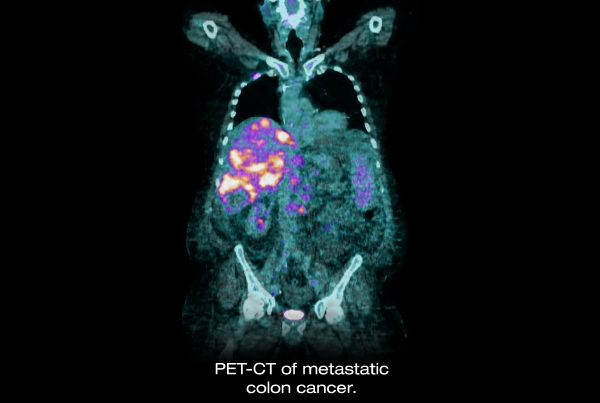Radioembolization of Metastatic Colorectal Cancer

New information regarding use as first line therapy in conjunction with systemic chemotherapy

Rolf Hultsch, MD
Hepatic yttrium-90 radioembolization, also known as selective internal radiation therapy (SIRT), is a form of brachytherapy used to treat primary and secondary liver tumors. This therapy is analogous to the perhaps better known chemoembolization procedure, with the difference being tiny 50 micron particles containing the beta radiation emitter yttrium-90 are infused into the hepatic artery instead of chemotherapeutic agents.
FDA-approval for the two available devices is for primary hepatocellular carcinoma and metastatic colorectal cancer (mCRC). Scottsdale Medical Imaging (SMIL) was among the first wave of private practices to offer this therapy about 10 years ago.
Despite being available for some time now the optimum point at which to deliver SIRT for mCRC remains uncertain. Plenty of published studies are available regarding safety and efficacy as a non-first-line therapy, and in actual practice most patients receiving radioembolization have previously been treated with systemic chemotherapy. That model may change in the future, however, following publication of a study in the May 20, 2016 Journal of Clinical Oncology1. This is the first large phase III randomized controlled trial investigating the use of radioembolization as a first line therapy given concurrently with systemic FOLFOX-based chemotherapy. SMIL was a participating site for this multicenter trial.
This study, named the SIRFLOX trial, randomized 530 chemotherapy naïve patients into two arms. The control arm received modified FOLFOX chemotherapy (mFOLFOX6). The study arm received similar chemotherapy with the addition of radioembolization given at the start of the first or second cycle of chemotherapy. Both arms were eligible to receive bevacizumab at the discretion of the treating oncologist.
An encouraging significant improvement was seen when considering only liver disease, with median progression-free survival (PFS) of 12.6 months for control versus 20.5 months for SIRT. This is noteworthy given that liver metastases are often considered to be a major cause of death in mCRC, so this may have an important implication on overall survival. That said, the primary endpoint of the study was overall PFS at any site, with both treatment arms showing similar results (median PFS 10.2 months control versus 10.7 months SIRT). Perhaps this was a predictable result given that SIRT has no expected effect on extra-hepatic disease.
Overall survival results are expected to be reported in 2017 after combining data with two similar not yet- completed trials, FOXFIRE and FOXFIRE Global, which will in total represent more than 1,000 patients. Adverse events for both treatment arms were in line with expectations, and concurrent delivery of chemotherapy and SIRT did not seem to unduly increase risk.
There are various approaches for incorporating yttrium-90 radioembolization in the overall treatment plan for metastatic colorectal cancer patients, and I believe this study lends support to first-line delivery concurrent with systemic chemotherapy. Use during a ‘chemo holiday’ also remains appropriate as well. Candidates for yttrium-90 should have limited extra-hepatic disease, total bilirubin less than 2.0 mg/dL, and reasonable functional status.
As always, all of us in the SMIL Interventional Radiology Department are happy to discuss options with other members of the oncology community. SMIL Interventional Radiologists can be reached for informal consultation, and patient appointments can be scheduled, through the IR Clinic at 480-425- 4150.
Reference:
1van Hazel, et al; SIRFLOX: Randomized Phase III Trial Comparing First-Line mFOLFOX6 (Plus or Minus Bevacizumab) Versus mFOLFOX6 (Plus or Minus Bevacizumab) Plus Selective Internal Radiation Therapy in Patients With Metastatic Colorectal Cancer. J Clin Oncol. 2016 May 20; 34(15):1723-31.

